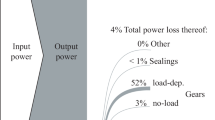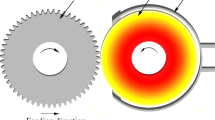Abstract
Rolling of high gears into full material is a new and economic way of manufacturing. Such gearings provide a higher surface strength and a better surface quality than conventional gearings. However, higher expenses for tools are disadvantageous. So far, the design of the forming tools follows only geometric requirements and the loads at the tool surface are not considered for designing these tools. To increase the life cycle of the tools, the loads at the tool surface and the stress state at the contact zone have to be taken into account. This paper presents an experimental setup to record strain data at the forming tool during the processing. Results of these measurements are shown for several stages of the process. Numerical simulations, according to the experimental tests, are shown in the second part. A staggered simulation with a two-dimensional model of the forming process is used to identify contact loads at the tool surface. These loads are transferred to a three-dimensional numerical model of the forming tool and the procedure to transfer loads is described in this article. The validation of the numerical results with the measured strain data shows the applicability of the numerical approach for designing tools.
Similar content being viewed by others
References
Hellfritzsch, U., Optimierung von Verzahnungsqualitaeten beim Walzen von Stirnradverzahnungen, Berichte aus dem IWU, Verlag Wissenschaftliche Scripten, Zwickau, Germany (2006).
Keil, S., Beanspruchungsermittlung mit Dehnungsmessstreifen, Cuneus Verlag, Zwingenberg, Germany (1995).
Window, A.L., Strain Gauge Technology, Elsevier Applied Science, London, UK (1992).
Stockmann, M., Mikromechanische Analyse der Wirkungsmechanismen elektrischer Dehnungsmessstreifen, Habilitation treatise, Chemnitz University of Technology, Chemnitz, Germany (2000)URL http://archiv.tu-chemnitz.de/pub/2000/0049).
Stockmann, M., Naumann, J., Schumann, J., and Mönch, I., “Differential Strain Gage – A Sensor Device for Macro- and Microsystems”, Strain, 47(s1): e104–e112 (2011).
Doege, E., Meyer-Notkemper, H., and Saeed, I., Fliesskurvenatlas metallischer Werkstoffe, Hanser Verlag, Muenchen Wien (1986).
Stahl-Eisen-Werkstoffblaetter (SEW) des Vereins Deutscher Eisenhuettenleute, Verlag Stahleisen Gmbh, Duesseldorf, Germany (1992).
Author information
Authors and Affiliations
Corresponding author
Rights and permissions
About this article
Cite this article
Kretzschmar, J., Stockmann, M., Ihlemann, J. et al. Experimental—numerical investigation of the rolling process of high gears. Exp Tech 39, 28–36 (2015). https://doi.org/10.1111/ext.12016
Received:
Accepted:
Published:
Issue Date:
DOI: https://doi.org/10.1111/ext.12016




